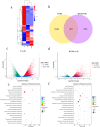Transcriptomic and metabolomic analyses provide insights into the biosynthesis of chlorogenic acids in Lonicera macranthoides Hand.-Mazz
- PMID: 34038434
- PMCID: PMC8153468
- DOI: 10.1371/journal.pone.0251390
Transcriptomic and metabolomic analyses provide insights into the biosynthesis of chlorogenic acids in Lonicera macranthoides Hand.-Mazz
Abstract
Lonicera macranthoides Hand.-Mazz (L. macranthoides) is a medicinal herb that is widely distributed in South China. The developmental stage and corolla dehiscence of the flower are the important factors affecting the quality of medicinal ingredients. However, neither the regulatory mechanism controlling chlorogenic acids biosynthesis in L. macranthoides nor the molecular basis of effect of corolla dehiscence on the quality of medicinal materials is fully understood. In this study, metabolomics and transcriptomics were used to analyze the metabolic and transcriptional differences of two different cultivars closed bud type (Bt), and flowering type (Ft), as well as the effect of jasmonic acid methyl ester (MeJA) on chlorogenic acids (CGAs) biosynthesis. In total, large number of differentially expressed genes (DEGs) and differentially accumulated metabolites (DAMs) were filtered among three lines of samples. Gene metabolite correlation analyses revealed a 'core set' of 30 genes and 54 genes that were strongly correlated with CGAs biosynthesis and regulating the flowering, respectively. Quantitative real-time polymerase chain reaction results proved the alterations in the expression levels of genes encoding the pathways involved in CGAs biosynthesis. The ion abundances of CGAs were most significantly increased, while some of the CGAs derived and Caffeoyl-CoA-derived substances showed the most largely reduced abundances in the closed bud type (Bt) compared to the flowering type (Ft). MeJA may leads to the activation of downstream genes in CGAs biosynthesis pathway. Overall, there were significant differences in the transcriptional and metabolic levels of CGAs biosynthesis pathway in flower buds of different flowering cultivars. The redirection of metabolic flux may contribute to increased accumulation of CGAs. However, whether MeJA and flowering have direct effects on the accumulation of CGAs needs further studied. These researches effectively expanded the functional genomic library and provide new insights into CGAs biosynthesis in L. macranthoides.
Conflict of interest statement
The authors have declared that no competing interests exist.
Figures







Similar articles
-
Transcriptome Analysis Reveals the Mechanism Underlying the Production of a High Quantity of Chlorogenic Acid in Young Leaves of Lonicera macranthoides Hand.-Mazz.PLoS One. 2015 Sep 18;10(9):e0137212. doi: 10.1371/journal.pone.0137212. eCollection 2015. PLoS One. 2015. PMID: 26381882 Free PMC article.
-
Integrated metabolic profiling and transcriptome analysis of Lonicera japonica flowers for chlorogenic acid, luteolin and endogenous hormone syntheses.Gene. 2023 Dec 20;888:147739. doi: 10.1016/j.gene.2023.147739. Epub 2023 Aug 24. Gene. 2023. PMID: 37633535
-
Exploiting genes and functional diversity of chlorogenic acid and luteolin biosyntheses in Lonicera japonica and their substitutes.Gene. 2014 Jan 25;534(2):408-16. doi: 10.1016/j.gene.2012.09.051. Epub 2012 Oct 17. Gene. 2014. PMID: 23085319 Free PMC article.
-
Should I stay or should I go: are chlorogenic acids mobilized towards lignin biosynthesis?Phytochemistry. 2019 Oct;166:112063. doi: 10.1016/j.phytochem.2019.112063. Epub 2019 Jul 4. Phytochemistry. 2019. PMID: 31280091 Review.
-
An outlook on chlorogenic acids-occurrence, chemistry, technology, and biological activities.Crit Rev Food Sci Nutr. 2013;53(9):968-84. doi: 10.1080/10408398.2011.576319. Crit Rev Food Sci Nutr. 2013. PMID: 23768188 Review.
Cited by
-
Transcriptomic and targeted metabolomic analyses provide insights into the flavonoids biosynthesis in the flowers of Lonicera macranthoides.BMC Biotechnol. 2024 Apr 12;24(1):19. doi: 10.1186/s12896-024-00846-5. BMC Biotechnol. 2024. PMID: 38609923 Free PMC article.
-
Carotenoid metabolomic and transcriptomic analyses provide insights into the flower color transition in Lonicera macranthoides.BMC Biotechnol. 2025 Jul 9;25(1):69. doi: 10.1186/s12896-025-01007-y. BMC Biotechnol. 2025. PMID: 40634871 Free PMC article.
-
Accumulation differences of high-value ingredients in different phenotype Lonicera macranthoides: insights from integrative metabolome and transcriptome analyses.Front Plant Sci. 2025 Mar 4;16:1533263. doi: 10.3389/fpls.2025.1533263. eCollection 2025. Front Plant Sci. 2025. PMID: 40104033 Free PMC article.
-
Regulatory mechanisms and biosynthesis of chlorogenic acid in Lonicera japonica: insights from tissue culture and inducer treatments.Front Plant Sci. 2025 Apr 24;16:1567140. doi: 10.3389/fpls.2025.1567140. eCollection 2025. Front Plant Sci. 2025. PMID: 40343127 Free PMC article. Review.
-
Genome-wide identification of LHT gene family in Lonicera macranthoides Hand.-Mazz and their responses to abiotic stresses.Front Genet. 2025 Jul 1;16:1614541. doi: 10.3389/fgene.2025.1614541. eCollection 2025. Front Genet. 2025. PMID: 40666075 Free PMC article.
References
-
- Xiao C, Wang Z, Tian L. Several proposed amendments to the criteria for Lonicera japonica and Lonicera macranthoides in "Chinese Pharmacopoeia". China Journal of Chinese Materia Medica. 2011; 3:1406–1407.
-
- Rai A, Kamochi H, Suzuki H, Nakamura M, Takahashi H, Hatada T, et al.. De novo transcriptome assembly and characterization of nine tissues of Lonicera japonica to identify potential candidate genes involved in chlorogenic acid, luteolosides, and secoiridoid biosynthesis pathways. Journal of Natural Medicines. 2017; 71(1):1–15. 10.1007/s11418-016-1041-x - DOI - PMC - PubMed
Publication types
MeSH terms
Substances
LinkOut - more resources
Full Text Sources
Other Literature Sources

